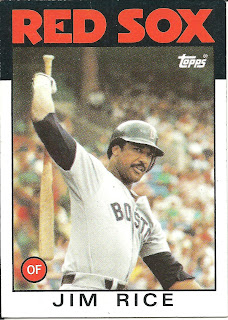Card
thoughts: An in-action shot on deck. Not often
you see one of those, but a nice “quiet moment” in a game picture.
The
player: You can make the case that Jim Rice has
benefited as much as Barry Bonds or Roger Clemens from steroids. In his case,
his borderline Hall of Fame power numbers looked pretty unimpressive when
stacked against sluggers in the steroid era. But voters had to vote for someone
to put in the Hall, and they had already sent in the obvious hitting stars of
the 80s: (Mike Schmidt, George Brett, and um Kirby Puckett?). So
Rice was chosen for the Hall in 2008, despite having numbers similar to Andres
Galarraga and Carlos Lee.
Known as “Ed” growing up in the segregated south, he
was one of the first African-Americans to attend a previous all white high
school in Anderson, South Carolina. But Jim was not the aggressive type,
despite his size, and his arrival did not seem to cause a lot of racial tension
(well, it was the early 70s and attitudes were changing).
Drafted in the first round by the Red Sox out of
high school, Rice showed a great power stroke at ever minor league stop. The
leagues he played in (New York-Penn, Florida State, and Eastern) are
notoriously pitcher friendly, so the numbers were even more impressive in
context. By the time Rice got to AAA
Pawtucket in 1974, it was clear he was ready for the majors as he won the
Triple Crown and MVP awards at that level.
In his first year as a regular (1975), Rice barely
missed a step clubbing 22 home runs and driving in over 100 en route to a
second place Rookie of the Year showing (his teammate #55 Fred Lynn won the
award, in what must have been the best rookie outfield duo in history).
Unfortunately for the Red Sox, a Vern Ruhle pitch broke his hand near the end
of the season, keeping him out of the World Series. It took awhile for the hand
to heal, and Rice endured a sophomore slump (although hitting 25 homers and driving
in 85 is still pretty impressive). But that season highlighted Rice’s only
weakness, as he led the league in strikeouts with 125. The other weakness was
his lack of patience. Despite being a slugger, Rice generally only walked 50
times or less a season.
The lack of patience didn’t seem to affect him
during a remarkable three year stretch (1977-1979) in which he led the league
in total bases each time (a feat that hadn’t been accomplished since Ty Cobb)
and won the MVP award in 1978, when the led the league in hits (213), triples
(15), home runs (46), runs batted in (139), slugging (.600) and OPS (.970).
After that remarkable three year runs, Rice’s hand
was injured again in 1980, leading to three straight years or good, not great,
power numbers. However, in 1982 he might have saved a young boys life. A
toddler was hit in the head by a foul ball, on Rice, in the on deck circle,
leapt into the stands and carried him into the Red Sox club house to be seen by
the team trainer.
1983 was a renaissance year for Rice, as he once
again led the league in home runs (39) and RBIs (126) while hitting .305. Three
more years of over 100 RBIs followed, but on the bad side, Rice was grounding
into over 30 double plays a year (with a record 36 in 1984), one of the reasons
that pitchers were so apt to pitch to the dangerous Rice with people on base.
After his last season with 200 hits (1986), Rice
began to slow down. While still a fearsome presence at the plate, he would
never again hit over 20 home runs or drive in over 100. The issue was eyesight,
elbow, and knee problems.
Rice would play his entire 16 year career with the
Red Sox. When he retired, he had 382 home runs, 2,452 hits, and 1,451 runs
batted in with a .502 slugging percentage. His home run total was 10th
best in American League history when he retired.
Rear guard: Two of Rice's home runs were solos; the other drove in fellow Hall of Famer Carl Yastrzemski.


No comments:
Post a Comment